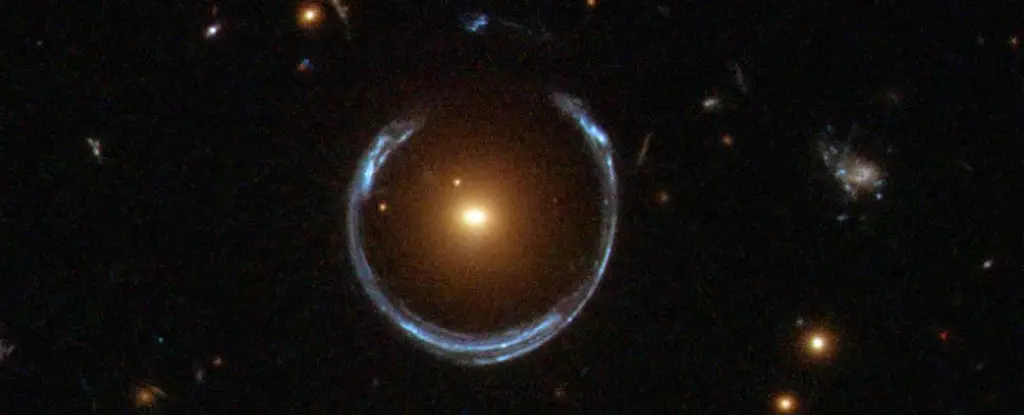In the vast expanse of the universe, discoveries often lead to an avalanche of questions, challenging our existing frameworks and inviting us to rethink the cosmic narratives we hold. Among these monumental revelations is the Cosmic Horseshoe, a remarkable gravitational lensing system that dazzles not only by its sheer beauty but also by the profound mysteries it unveils about our universe.
First identified in 2007, the Cosmic Horseshoe is a system comprising a foreground galaxy that acts as a cosmic lens, distorting and magnifying the light from a more distant background galaxy. This celestial alignment allows astronomers to observe features of the far-away galaxy that would otherwise be undetectable. Situated an impressive five-and-a-half billion light-years away, the Cosmic Horseshoe showcases an Einstein Ring—a visual phenomenon where the gravitational influence of the foreground galaxy creates a halo-like structure around the background galaxy’s image.
Recent investigations have revealed that this gravitational lensing galaxy, specifically labeled LRG 3-757, harbors an astonishing Ultra-Massive Black Hole (UMBH) at its center, boasting a mass equivalent to 36 billion solar masses. This black hole doesn’t just challenge our understanding of cosmic structures; it also serves as a vital piece in the intricate puzzle of galaxy evolution.
While astronomers have long recognized supermassive black holes (SMBHs) that commonly reside at the hearts of galaxies, the classification of UMBHs has emerged to encompass black holes that exceed 5 billion solar masses. The term itself came about as astronomers observed increasingly massive black holes, highlighting the need to categorize the extremes in the black hole hierarchy efficiently.
This discovery sheds light on the evolving landscape of black hole research, which has transitioned from merely identifying their existence to a more nuanced understanding of their correlation with galaxy formation and development. The sheer mass of the UMBH found in the Cosmic Horseshoe marks a significant milestone in our quest to comprehend these incredible cosmic entities.
A Study of Relationships: Exploring the MBH-Sigmae Relation
The relationship between black holes and their host galaxies has gained considerable attention, particularly through the establishment of the MBH-sigmae Relation. This vital connection illustrates that larger SMBHs correlate with higher velocity dispersions among stars within a galaxy’s bulge. As the black hole’s mass grows, so too does the dynamism of surrounding stars, revealing an intrinsic relationship between galactic structures and their central black holes.
However, the UMBH in the Cosmic Horseshoe significantly outstrips the predictions made by this established correlation. The study reveals that LRG 3-757 is approximately 1.5 sigma above the expected MBH-sigmae line, suggesting that at the highest mass levels, other factors may influence the evolutionary pathways of galaxies and their central black holes. This divergence raises essential questions about the history and dynamics of interactions within massive galaxies.
Anomalies such as the decoupling of the MBH-sigmae relationship in LRG 3-757 present an opportunity for astronomers to reevaluate their understanding of cosmic evolution. One potential explanation lies in past galaxy mergers that could have affected the stellar velocity dispersion within LRG 3-757. The concept of a “fossil group” comes to light here, referring to a late-stage evolution in which galaxies have ceased significant star formation activities.
Another intriguing possibility is the phenomenon of “scouring” during galaxy mergers, whereby interactions between two huge galaxies could lead to the expulsion of stars, resulting in altered stellar motion while leaving the black hole’s mass intact. Alternatively, feedback from Active Galactic Nuclei (AGN) may play a role, as jets and outflows could impact forming stars and galactic structures. Each proposed scenario opens the door to new investigations that could offer explanations for the complex behaviors observed in massive galaxies.
The unveiling of the extraordinarily massive black hole at the heart of the Cosmic Horseshoe represents not just an isolated discovery but a stepping stone towards enhanced understanding of the cosmos. Upcoming missions such as Euclid are set to revolutionize our knowledge, with the potential to uncover hundreds of thousands of additional gravitational lenses in the coming years. The Extremely Large Telescope (ELT) will further empower researchers with detailed studies of galaxy dynamics, velocity dispersion, and the interrelationship between dark matter and baryonic matter.
As we venture into this exciting new phase of astronomical research, the challenge remains to interpret the myriad complexities of our universe accurately. The findings surrounding the Cosmic Horseshoe remind us that with each discovery comes an expanded universe of questions, urging us ever forward in our quest for cosmic comprehension.

